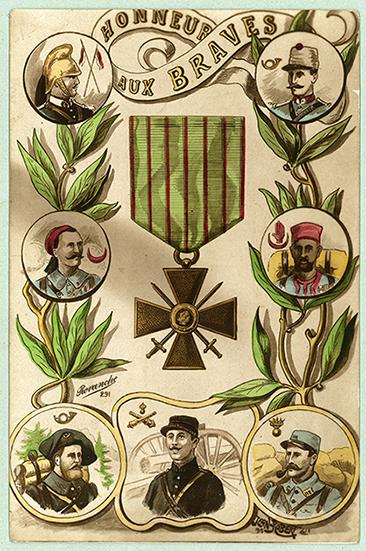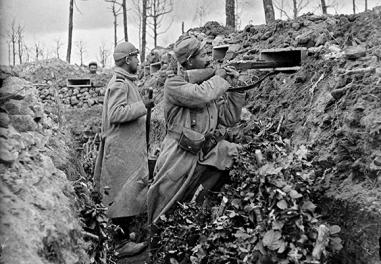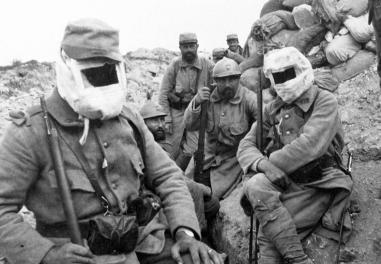The Croix de Guerre is 100 years old
Right from the first battles in the summer of 1914, a shortcoming was quickly detected in the French system of rewarding deserving combatants. It was not until April 1915 that the Croix de Guerre was created which was then to become the very symbol of victorious First World War soldiers. Vidéo commémorative du 11/11/2015

At the beginning of the war, French soldiers only had the military medal and the Legion of Honour to reward their merits. Yet the conditions under which these decorations were attributed did not reward all heroic wartime acts. From October 1914, General Boëlle drew the attention of the Government to this issue. It was not until 2 April 1915 that the law establishing the Croix de Guerre was adopted following much bitter parliamentary debate. Indeed, Alexandre Millerand, Minister of War, saw no need for such a decoration since the daily citations were mentioned in the army's Official Bulletin. The project, promoted mainly by journalist Maurice Barrès and Lieutenant Lieutenant-Colonel Driant sought instead to create a decoration that gave material shape to these citations, visible evidence of the courage of the fighters.
Even before the Act was adopted, a competition had been launched to create the badge of the future decoration. The call for projects was a great success since more than 30 models were proposed. The model chosen, designed by the engraver Bartholomew, is simple and sober. It consists of a Florentine bronze cross patée, with two crossed swords between the arms. On the obverse is the effigy of the Republic and on the reverse the year the cross was awarded. The Green red-striped ribbon, is evocative of the Medal of St. Helena. This reminder displeased opponents of the new decoration through its reference to the Empire. For others, the religious connotation of the word "cross" was questionable. Yet, despite the difficulties and criticism, the new decoration was a huge success.
One of the innovations in the new design was to enable each act of bravery to be clearly materialised without however having to add new decorations. This was due to an ingenious system of clips that are attached to the ribbon. A small bronze star (citation at the regiment or brigade level), silver star (citation at division level) or silver gilt star (citation at army corps level) represented the level of each citation. Citations at army level were shown by a bronze palm, with five palms being replaced by a silver palm. While some solders gained large numbers of citations, such as the 'aces' René Fonck (28 palms) or Georges Guynemer (26 palms), this measure was hardly ever applied. The second novel feature of the Croix de Guerre was that it could be awarded to anyone: all ranks, French and foreigners, but also civilians, including women, were eligible to receive it. Legal entities (2,952 towns and villages and over 800 military units) and even animals were honoured with the new decoration. At the end of the war, over two million citations had been awarded, for a total of 1.2 million Croix de Guerre medals awarded.
Soon the Croix de Guerre was everywhere: trench craftwork, memorials, badges of veterans' associations... Simple and recognisable, the medal became the symbol of the valour of the soldiers. Other countries were inspired by this decoration to create their own Croix de Guerre, sometimes very similar in terms of aesthetics and the way the medal was awarded like Belgium for instance (1915). Portugal (1916), Greece (1917) then Czechoslovakia (1919) imitated the cross.
This decoration had a lasting influence on the French rewards system, to such an extent that other war crosses were introduced: in 1921, for external operation theatres
(operations in the interwar period, then the Indochina war and Suez operation), in 1939 for the Second World War. Finally, the Cross of Military Valour, used in the same way, was created in 1956 for operations in North Africa and subsequent operations where the French army intervened. One hundred years after its creation, it is still being awarded and perpetuates the spirit of 1915.
Articles of the review
-
The file

The year 1915 – Putting an end to the trenches
The hecatombs of 1914 surprised and took aback senior army command. Once the front got bogged down, trench warfare turned out to be just as deadly as mobile warfare and did not enable any of the belligerents to gain a decisive upper hand. So how could you do away with the trenches and win this war a...Read more -
The event

The massive use of poison gas
Read more -
The interview

Nicole Buresi
Agrégée (holder of highest teaching diploma in France) in Literature and a playwright, this teacher ran a writer's workshop for six months on the Great War. Nicole Buresi told us about this joint work that culminated with the publication of a novel, Bassoles goes off to war.
Read more

